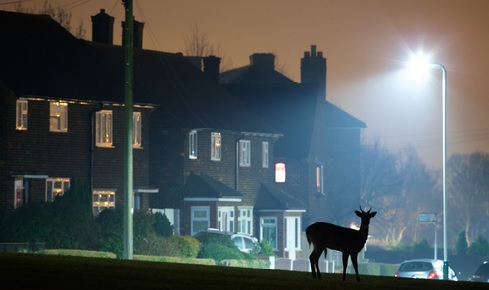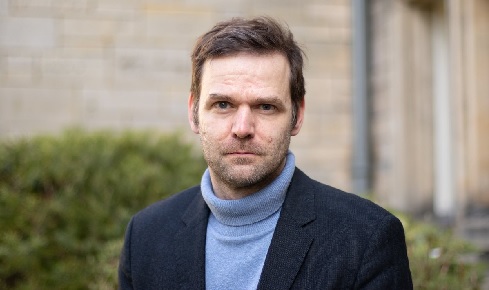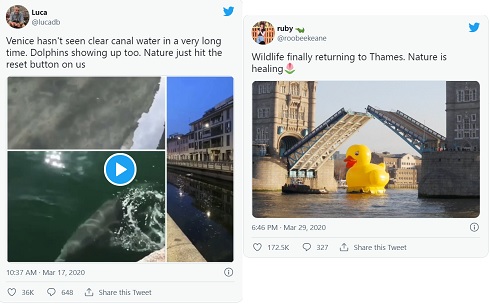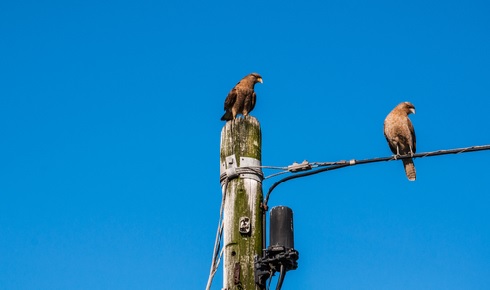Is nature healing?

The ‘anthropause’ caused by COVID-19 restrictions has allowed nature to temporarily rebound in some ways, but also reveals how crucial humans are to the fates of animals and ecosystems, Professor Christian Rutz tells Tom Ireland
September 8th 2021
It is estimated that in April 2020, over half of the entire world’s population were confined to their homes as Governments responded to the escalating COVID-19 crisis with strict lockdown or quarantine measures.
In a paper[1] published later that year, Professor Christian Rutz and his co-authors coined the term ‘anthropause’ to describe this massive, sudden, global reduction in human mobility. (The word went on to feature in the Oxford English Dictionary’s words of the year alongside ‘furlough’ and ‘covidiot’.) The paper set out how the global lockdown – although born out of tragic circumstances – represented an unprecedented opportunity to quantify the effects of human activity on wildlife and the environment generally.
Rutz, a professor in the School of Biology and the University of St Andrews, is now co-leading a global consortia of biologists, data scientists, conservationists and geographers to pool bio-logging data from before, during and after the lockdowns of 2020, in order to build a picture of the effects on different species in different places. Rutz hopes that this could provide key lessons on how we can live alongside wildlife more harmoniously.
In the media and on social media, it has been assumed that amid this vast and sudden reduction in human activity, wildlife and ecosystems were recovering from the pressures we have put them under. But the real picture, of course, is far more complicated than that.
 Professor Christian Rutz, founding president of the International Bio-Logging Society is helping to pool millions of data points to understand how wildlife was impacted by the widespread lockdowns of 2020.
Professor Christian Rutz, founding president of the International Bio-Logging Society is helping to pool millions of data points to understand how wildlife was impacted by the widespread lockdowns of 2020. In terms of reductions in human activity, has there ever been anything comparable to this before?
There have been sudden reductions in human activity confined to a certain area – for example the Chernobyl and Fukushima disasters led to exclusion zones where human activity basically was reduced to near zero. The plague which affected large numbers of people across Eurasia and North Africa caused major disruption to human activity.
When we were coining the term ‘anthropause’ we really were thinking about this global scale shock to the system COVID-19 has caused. This really is unprecedented – I can't think of any other circumstance where scientists have an opportunity to study human-wildlife interactions in this quasi-experimental manner, at such spatial scales and across so many different taxa.
What is important to say is that in most cases, any reduction in human activity is associated with massive human suffering. As we made quite clear in the paper we published last year, we think it is very important to keep that in mind when considering this as a research opportunity. First and foremost, many people during the COVID-19 pandemic lost their lives or lost loved ones: it's a massive human tragedy.
Bearing that in mind, can you tell me a bit more about the types of studies that could benefit from these extraordinary times?
We felt that these extraordinary conditions afforded a research opportunity which we as a community couldn't afford to miss. It enables us as ecologists to look at the effect of changing human activity levels across sites and across systems, across species and terrestrial ecosystems, and in the marine realm. Of course, you have the temporal component as well, so you can look at systems before, during and after lockdown.
These are basically the key ingredients you need for something ecologists or environmental scientists call a 'before after control impact design'. So you compare a system before and after the perturbation happens, and you have additional control sites where no perturbation happens. Those could be areas that are so remote that it didn't really matter whether humans were locked down or not and the change in disturbance is quite minimal.
One of the key objectives of the COVID-19 Bio-Logging Initiative is to use animal tracking data to specifically inform how we humans can share quite limited space on this planet with other animals, and to look at opportunities for restructuring transport networks and our general day to day behaviours, in a way that that benefits the natural world.
I should say here that we are not asking, and we will never ask, for humans to stay home – that's not a viable proposal. What we hope to get is ideas about how we can make very small tweaks to the way we live our lives – that don't impact what we enjoy or have to do – but have significant benefits for other animals.
That could be changing the topology of a road network, it could be changing the timing of vessel traffic in particular areas, it could be a very time-limited protection of a particular area that is very important for a local animal population. There are reports of some sea turtle populations, for example, really benefiting from the absence of humans on their nesting beaches. We're talking a window of a few weeks that makes a massive difference for these animals.
Hopefully, those are the kinds of lessons we can learn and can take forward as we are thinking about how to live our post-pandemic lives.
What have the first results from studies investigating lockdown effects on wildlife suggested is happening?
The first indications are that it's a mixed bag of effects. So although the initial response from the media and on social media was to focus on this idea that nature is rebounding and everything is better when there are fewer humans out and about, there are actually quite a number of studies that illustrate that humans, in modern human-dominated landscapes, fulfil a very important role as custodians of biodiversity. Once they are no longer available to do their monitoring and protection work, then certain systems can come under increased pressure.
Many of us have personal experiences of seeing wild animals in places where we hadn't noticed them before. That is what led to these headlines in the media about nature rebounding or ‘healing’. We have to take those anecdotal observations with a pinch of salt, because there are likely observation biases: we had more time to look for wildlife as we were asked to stay at home, and more people developed an interest in wildlife watching.
However it looks as if some studies that use more controlled data collection have indeed found such effects for some species – that they moved more widely and explored areas that they would not otherwise visit. For example, in Israel there are reports of griffon vultures roaming more widely when air traffic was reduced. In terms of other positive effects, there are now compelling quantitative studies documenting a reduction in roadkill.
There are also negative effects. As I mentioned, some species have come under increased pressure because they have come become quite reliant on food discarded or intentionally provided by humans. Also, in places where wildlife wardens were no longer able to patrol or there were fewer eyes to watch out for criminal activities, there is clear evidence to show that led to increased levels of persecution and poaching. There are reports of increased use of snares in areas of Uganda and of a spike in raptor persecution in the UK, for example. So we need to view these effects on a case by case basis, species by species. It's a fairly nuanced story.
 Twitter memes make fun of exaggerated claims that ‘nature is healing’, during the first wave of lockdowns across Europe in 2020.
Twitter memes make fun of exaggerated claims that ‘nature is healing’, during the first wave of lockdowns across Europe in 2020. In terms of animal ranging behaviour increasing, which I think is probably the focus of most of the media attention – goats taking over a town in Wales springs to mind – is that necessarily always a positive thing for those animals? They might find nothing useful to them, or come into danger.
That is a very good point – we shouldn't interpret all of these occurrences of wildlife in unusual places as a positive outcome. And of course we shouldn't forget that this reduction in human activity is a transient phenomenon. Whatever opportunities may have arisen may close again post-pandemic.
At the same time, I would say that this provides animals with an opportunity to gather information about their environment, to learn about the availability of resources and perhaps also to have an opportunity to habituate to human presence as they re-enter the landscape.

"The project offers an opportunity to go beyond just tracking, with a large number of studies on raptors globally that also collect data on things like diet composition, pollution levels, and reproductive output. We decided to try and capitalise on that by launching this initiative that looks at the responses of raptors to lockdown effects more broadly, including including longer-term, population-level consequences.
While our COVID-19 biologging initiative has secured funding through the Gordon and Betty Moore Foundation and the National Geographic Society, we are still looking for support for the raptor project. We have just published a paper that shares our vision for that project and indicates how these lockdown analyses could really transform raptor conservation globally, if we move fast and make good use of these lockdown data.”
Could you explain how the COVID-19 Bio-Logging Initiative collects data on animal behaviour?
It brings together researchers from around the world that use small tracking devices to find out where animals go when humans can't observe them. Those are GPS loggers in most cases that give positional data and allow wildlife ecologists to see where an animal flies or swims or hops. In other cases, those tags include additional sensors, like accelerometers, that allow us to make inferences about the animal's activity.
This is a very active field and each year hundreds of studies deploy these tracking devices on to their chosen study species – from small songbirds to large whales and everything in between. We realised that when the world went into lockdown early last year, tens of thousands of tags remained on these animals and they continued collecting and delivering data, which is a goldmine of information we can tap.
So, we mobilised the international biologging community, asking who had tags on animals and who could potentially share data. Within a few weeks we had hundreds of responses, we had this amazing response from the community. That convinced us that there was enough support to build a consortium.
Over the past 12 months we've brought together researchers, data analyst experts, human geographers, all sorts of colleagues who can contribute relevant expertise to pull together these animal tracking data sets. We then combine them with information on changes in human mobility to analyse these anthropause effects on animal movement.
By the latest count, we've been offered data for over 13,000 tagged animals from all of the world's oceans, all continents, and across taxonomic groups, from small terrestrial animals to large marine mammals. We are expecting to pass 1 billion GPS fixes pretty soon.
It's important to make very clear that our initiative is open to everybody, so it's not restricted to people who are data owners. We welcome contributions in terms of expertise local knowledge, conservation expertise. That is the spirit of these projects, they are community driven and are not the initiatives of one particular research group. This is meant to be a vehicle for the research community to come together to produce useful outputs.
What are the next steps and what do you foresee happening with all this data in the future?
Developing the necessary infrastructure for a project of this scale was no trivial feat and we’ve spent a long time on that. If you imagine you've got hundreds of projects contributing data sets that are formatted in slightly different ways, that creates real challenges in terms of data harmonisation, standardisation and ownership.
We are now at the stage where we are crunching the numbers. I think we can expect first papers on questions focussed on certain taxonomic groups or regions to come out in the near future.
In terms of the analysis required, it's really complex work and some projects will take longer. We know that there is a sense of urgency. We know that the world wants to hear the answers to some of these questions. We have plans to ultimately pool all the data to paint a global picture of anthropause effects on animal movement. That will be most likely the crowning output of these initiatives, but that will take years to accomplish.
The COVID Bio-Logging Initiative is funded in part by the Gordon and Betty Moore Foundation and the National Geographic Society.
Dr Christian Rutz is a professor in the School of Biology at the University of St Andrews and Founding President of the International Bio-Logging Society.
Reference
1. Rutz, C., Loretto, MC., Bates, A.E. et al. COVID-19 lockdown allows researchers to quantify the effects of human activity on wildlife. Nat Ecol Evol 4, 1156–1159 (2020).


